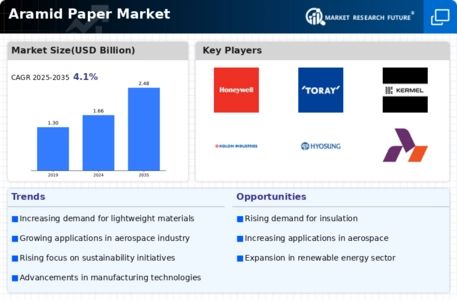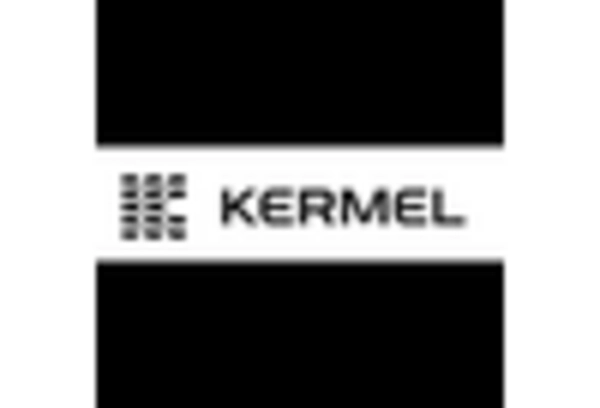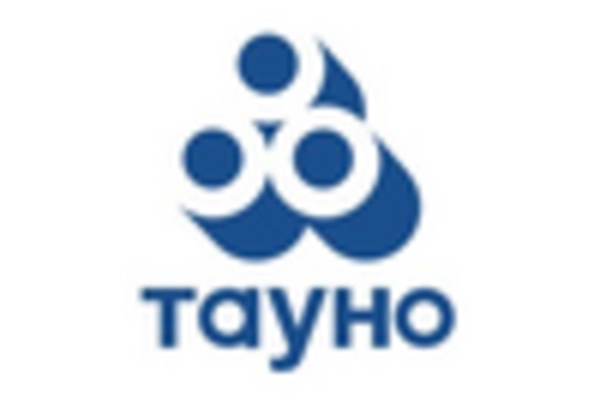Innovations in Manufacturing Processes
The Aramid Paper Market is being influenced by innovations in manufacturing processes that enhance the production efficiency and quality of aramid paper. Advances in technology, such as automated production lines and improved raw material processing, are enabling manufacturers to produce aramid paper with greater consistency and lower costs. This is particularly relevant as the market faces increasing competition from alternative materials. The introduction of new manufacturing techniques could potentially reduce production costs by up to 15%, making aramid paper more accessible to a wider range of industries. As these innovations unfold, they are likely to strengthen the position of the Aramid Paper Market in various applications, from automotive to electronics.
Rising Demand for Lightweight Materials
The Aramid Paper Market is experiencing a notable increase in demand for lightweight materials across various sectors, including automotive and aerospace. This trend is driven by the need for enhanced fuel efficiency and performance. As manufacturers seek to reduce weight without compromising strength, aramid paper, known for its high strength-to-weight ratio, becomes an attractive option. The market for lightweight materials is projected to grow at a compound annual growth rate of approximately 7% over the next five years, indicating a robust opportunity for aramid paper applications. Furthermore, the shift towards lightweight solutions aligns with broader industry goals of sustainability and efficiency, further propelling the Aramid Paper Market forward.
Expansion in Aerospace and Defense Sectors
The Aramid Paper Market is poised for expansion, particularly within the aerospace and defense sectors. The unique properties of aramid paper, such as high tensile strength and resistance to extreme temperatures, make it a preferred material for various applications, including aircraft components and protective gear. The aerospace industry is projected to grow at a rate of 4% annually, with increasing investments in defense technologies further driving demand for high-performance materials. As these sectors continue to evolve, the Aramid Paper Market is likely to benefit from the heightened focus on safety, durability, and performance, positioning aramid paper as a critical material in advanced aerospace and defense applications.
Growth in Electrical Insulation Applications
The Aramid Paper Market is witnessing significant growth in the electrical insulation sector. Aramid paper's excellent dielectric properties make it an ideal choice for insulation in electrical components, such as transformers and motors. The increasing demand for energy-efficient electrical systems is likely to drive the adoption of aramid paper in this domain. According to recent estimates, the electrical insulation market is expected to reach USD 30 billion by 2026, with aramid paper playing a crucial role in meeting the stringent performance requirements. This growth in electrical insulation applications not only enhances the market potential for aramid paper but also underscores its importance in advancing energy efficiency and reliability in electrical systems.
Increasing Focus on Fire-Resistant Materials
The Aramid Paper Market is experiencing a heightened focus on fire-resistant materials, driven by stringent safety regulations across multiple industries. Aramid paper's inherent flame-retardant properties make it an ideal candidate for applications in construction, automotive, and protective clothing. The global market for fire-resistant materials is anticipated to grow significantly, with projections indicating a CAGR of around 6% over the next several years. This trend is likely to bolster the demand for aramid paper, as industries seek to comply with safety standards while ensuring performance. The emphasis on fire safety not only enhances the relevance of aramid paper but also positions the Aramid Paper Market as a key player in the development of safer materials.


















Leave a Comment